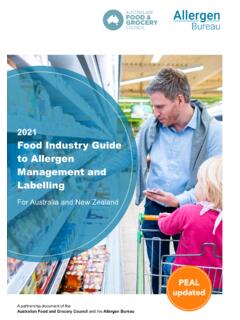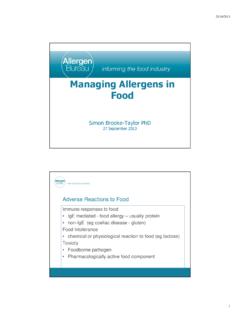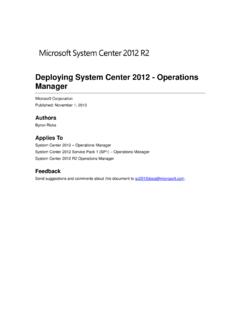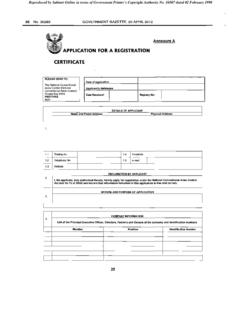Transcription of Food Industry Guide to the Voluntary Incidental Trace ...
1 Food Industry Guide to the Voluntary Incidental Trace Allergen Labelling (VITAL) Program Version april 2012 Food Industry Guide to the Voluntary Incidental Trace Allergen Labelling (VITAL) Program Version Allergen Bureau has provided VITAL and associated documentation on the basis and understanding that users exercise their own skill, care and judgement with respect to its Allergen Bureau provides no warranty with regards to the results generated by VITAL that they will be free from error, or if used will ensure compliance with all applicable laws and regulations guiding food labelling.
2 Before relying on the results generated by VITAL for use in determining appropriate allergen labelling, you should carefully evaluate the accuracy, completeness and relevance of the results for your purposes, and should obtain appropriate expert advice relevant to your particular that the accuracy of recommendations of VITAL will be dependent on the accuracy of the data provided by accessing VITAL, you acknowledge that in no event shall the Allergen Bureau be liable for any direct or indirect losses or damages including Incidental or consequential losses or damages resulting from its use and release the Allergen Bureau from any liability existing now or in the the data used in VITAL is being continually updated, we would recommend you review any use of VITAL at your discretion.
3 Copyright: Copyright The Allergen Bureau work is protected by copyright. VITAL has been developed by the Allergen of UseThe Allergen Bureau grants you a non-exclusive, non-transferable right to access, use and display of VITAL and associated documents, provided that you comply fully with these terms of use. You may display, print and reproduce this material in unaltered form only (retaining this notice) for your own personal use or use within your organisation. Apart from any other use permitted under the Copyright Act 1968 (Cth), all other rights are reserved.
4 You do not obtain any ownership right, title or other interest in VITAL copyrighted materials by downloading or otherwise using these may not use any part of VITAL to establish, maintain, or provide, or assist in establishing, maintaining or providing your own publications, whether on the internet or otherwise. In particular, you may not sell access to VITAL or any material derived from VITAL or use VITAL for any commercial benefit anywhere in the world otherwise including adapting, appropriating or copying any part of for further authorisation should be directed to:The Allergen Bureau Industry Guide to the VITAL Program Version (23 april 2012 ) Allergen Bureau 1 Food Industry Guide to the Voluntary Incidental Trace Allergen Labelling (VITAL) Program Version Background Information page 2ii.
5 The Regulatory Framework & VITAL page 2iii. The VITAL Program page 2iv. The VITAL Program Objective page 3v. Use of VITAL page 3 Application of VITAL (The VITAL Procedure)i. Definitions page 4ii. Scope page 6iii. Pre-requisites page 6iv. Determination of relevant allergens page 6v. Identification of intentionally added allergens page 6vi. Identification and quantification of cross contact allergens due to ingredients page 6vii. Identification and quantification of cross contact allergens due to processing page 7viii. Calculation of total cross contact allergen in finished product page 8ix.
6 Determination of Action Levels page 9x. Review of labelling recommendations and of sources of cross contact page 9xi. Recording of assumptions page 10xii. Validation of VITAL Risk Assessment page 10xiii. Ongoing monitoring page 11 Additional information for VITAL usersi. VITAL and Allergen Analysis page 12ii. Decision Tree for Cross Contact Allergens page 142 Allergen Bureau Food Industry Guide to the VITAL Program Version (23 april 2012 )PREFACEFood regulations in many countries require the mandatory declaration of certain allergens in food.
7 In addition to named allergens present in a food due to direct, intentional addition, allergens may also be present, even under conditions of Good Manufacturing Practice (GMP), due to cross contact with other materials. This could occur at any point along the food chain from primary production, ingredients and through the manufacturing process. Voluntary Incidental Trace Allergen Labelling (VITAL) has been developed to provide a risk based methodology for food producers to use in assessing the impact of allergen cross contact and provide appropriate precautionary allergen labelling.
8 Application of this approach aims to avoid indiscriminate use of precautionary labelling and thereby preserve its value as a risk management tool. It will therefore contribute to minimising risk while communicating effectively to allergic uses a two level Action Level grid to assist in determining if the presence of residual protein from allergenic substances through unavoidable cross contact requires a precautionary labelling Background InformationThe first version of VITAL was released in June 2007 in Australia and New Zealand to provide a risk-based assessment process to determine when a precautionary allergen labelling statement (May be present)
9 Is 2010 the Allergen Bureau initiated a review of VITAL, building on a commitment to continue to invest in VITAL to ensure that it remains a relevant tool for Industry . The Allergen Bureau recognised a need to form a scientific expert panel, known as the VITAL Scientific Expert Panel (VSEP) to review the science underpinning the VITAL Action Level Grid. The scientific review was a critical body of work to ensure that the Action Levels protect the allergic consumer by enabling Industry to make appropriate precautionary labelling decisions and provide clear and consistent consumer communication through the use (or not) of the May be present The Regulatory Framework & VITALVITAL has been developed against the Australian/New Zealand regulatory background.
10 VITAL is applicable for allergen substances listed in the Australia New Zealand Food Standard Code Standard , Table to Clause 4. Additional allergens (lupin, mustard) have been added to the VITAL Action Level Grid and further allergens may be included when there is sufficient scientific data available to set a Reference Dose. It is the responsibility of the user to determine the cross contact allergens that may impact their product and to ensure the appropriateness of using VITAL in their market. iii. The VITAL ProgramThe VITAL Action Level Grid contains concentrations of cross contact allergens, called Action Levels, which determine when it is appropriate to use a precautionary allergen statement.









